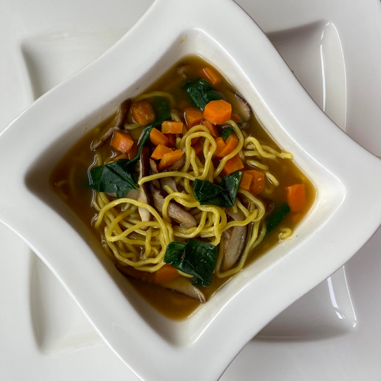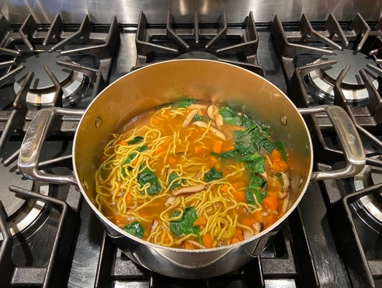Recipes for Managing Side Effects Series: Nausea
Each month, we are highlighting some of our favorite recipes for reducing side effects related to cancer treatment. Historically, ginger has been used to reduce gastrointestinal issues from vomiting to diarrhea. Lucky for us, there are many ways to enjoy ginger, from simple teas to complex dishes. Your tastes may vary, but ginger will be your friend in reducing nausea.
Nutritional Content and Health Benefits
Ginger has been used medicinally throughout the ages for the relief of gastrointestinal issues [i]. However, research has now found that ginger reduces nausea and vomiting in general and in cancer patients undergoing chemotherapy [i, ii, iii]. Active nausea reducing components in ginger are gingerols and shogaols, shogaols being dehydrated gingerols. Therefore, gingerols are primarily present in fresh ginger, whereas shogaols are primarily present in dried ginger [ii]. Studies have shown that 1 gram (~1 teaspoon fresh) of ginger total per day, whether fresh or dried, is beneficial in reducing nausea and vomiting [i]. No adverse reactions were noted until consumption was over 4 grams. The adverse reactions were gastrointestinal issues including nausea and vomiting [i].
Other ways to reduce nausea and vomiting include eating a diet rich in antioxidants and polyphenols, and avoiding strong orders [iv, v]. The easiest way to do this is by adding as many fruits and vegetables to your diet as possible. A sense of smell is proven to be one of the main ways to induce vomiting as a defense mechanism against poisoning. Because of this, don’t overdo your ginger intake!
How to Use
A little ginger goes a long way. For your best defense again nausea and vomiting, use one teaspoon of fresh or ground ginger. If you enjoy the taste, feel free to add more, not going over 4 grams per day.
Recipe
Ginger Soup
Yield: 4 servings
NOTE: This recipe was designed to limit strong odors while increasing antioxidants and polyphenols. If you prefer and can tolerate stronger flavors, feel free to adjust ginger content or replace white wine with rice wine vinegar.

Ingredients
- 2 tablespoons canola oil
- 4 teaspoons freshly grated ginger
- 4 oz sliced fresh mushrooms
- ¼ cup white wine
- 2 cups carrots diced
- 6 cups water
- 1/3 cup soy sauce
- 2 cups fresh spinach
- 16 oz fresh or dried ramen noodles
Instructions
- Heat oil on medium-high in a 5-quart pot.
- Add ginger and stir until fragrant, approximately 30 seconds.
- Add mushrooms and cook until crispy, approximately 3-5 minutes.
- Add white wine, scraping all the crispy bits from the bottom of the pot.
- Add carrots, water, and soy sauce. Bring to a boil, then reduce to simmer for 15 minutes.
- Add spinach and stir until wilted.
- If you plan to eat immediately, add ramen noodles, stir until cooked, and serve.
- If you plan to save for later, store soup appropriately. Reheat and add noodles at the time you plan to consume.
For more tips on managing nausea, check out this post.
References:
[i] Lete I, Allué J. The Effectiveness of Ginger in the Prevention of Nausea and Vomiting during Pregnancy and Chemotherapy. Integr Med Insights. 2016;11:11-17. Published 2016 Mar 31. doi:10.4137/IMI.S36273
[ii] Marx W, Ried K, McCarthy AL, et al. Ginger-Mechanism of action in chemotherapy-induced nausea and vomiting: A review. Crit Rev Food Sci Nutr. 2017;57(1):141-146. doi:10.1080/10408398.2013.865590
[iii] Saneei Totmaj A, Emamat H, Jarrahi F, Zarrati M. The effect of ginger (Zingiber officinale) on chemotherapy-induced nausea and vomiting in breast cancer patients: A systematic literature review of randomized controlled trials. Phytother Res. 2019;33(8):1957-1965.
[iv] Serna-Thomé G, Castro-Eguiluz D, Fuchs-Tarlovsky V, et al. Use of Functional Foods and Oral Supplements as Adjuvants in Cancer Treatment. Rev Invest Clin. 2018;70(3):136-146. doi:10.24875/RIC.18002527
[v] Maharjan A, Peng M, Cakmak YO. Non-invasive High Frequency Median Nerve Stimulation Effectively Suppresses Olfactory Intensity Perception in Healthy Males. Front Hum Neurosci. 2019;12:533. Published 2019 Jan 21. doi:10.3389/fnhum.2018.00533


This is excellent, Susan. I wanted to let you know that Essential Puree is creating samples for a line of frozen pureed foods for those with swallowing disorders and dysphagia. As you may well remember, I am an Asia scholar with the background in the Chinese and Japanese kitchens. This ginger soup is a wonderful idea. I would like to contact you when we are ready to do patient tastings. I would like to have neck and throat cancer patients taste our line and give us some feedback in a short questionnaire. We use the Harvard School of Public Health Eating Plate as our template. Whole foods, no chemicals or preservatives. Please let me know.